All Articles
Singing Along: The Ballad of The Towne Criers
- By Brad Myers
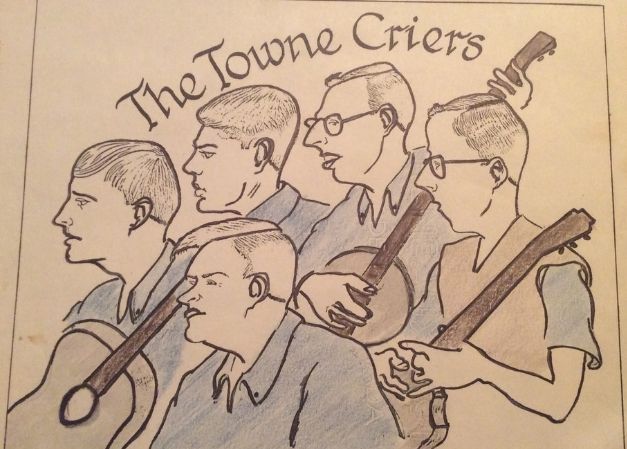
THE BALLAD OF THE TOWNE CRIERS 1961-1965
This Singing Along post, as the FCLMA London Music Hall of Fame’s celebrates our folk music history, is The Ballad of The Towne Criers by Brad Myers. It tells of a London folk group’s gigs and encounters with stars and future stars in the early 1960s.
Thanks to founding member Brad Myers for his recollections, aided by his personal scrapbook and that of the late Larry Walsh.
Another founding member, Ken Wilson, graciously provided photos of the final three incarnations of the group, as well as his recollection of the group's meeting with a then 19-year-old Neil Young.
— FCLMA London Music Hall of Fame
As seen above, an early Towne Criers promotional piece presents a memorable group image of the folk quintet, all students at the old Sir Adam Beck Collegiate. It was drawn by commercial artist Pender Crichton, father of the group’s bass singer Iain Crichton.
in the beginning, there was Beck
The Towne Criers was a London-based folk music group that had its origins, as did The Four Freshmen and The Four Preps, at an educational institution. For The Towne Criers, it was at Sir Adam Beck Collegiate during the 1961-1962 school year. The founding members were Tim Rowat (leader), Iain Crichton, Brad Myers, Larry Walsh, and Ken Wilson.
Brad gravitated into folk music after playing lead guitar and/or bass in London rock & roll bands Gary & The O’Teens (later called The Impressions); The Undertakers; and Ken Maddox & The Mystics.
As he transitioned from rock to folk, he sold his bass amp in Toronto, and, later the same day, used the proceeds to buy a 1947 Martin D-28 guitar at a Toronto pawn shop. This became his main instrument. He also played a long-neck banjo from time to time.
After diligent practice of the folk songs of the day during 1962 and early 1963, the group had its official debut at the Hotel Iroquois Supper Club on May 15, 1963. Their performance was reviewed by Bill Webster of The London Free Press in his column, Showbeat: “They made a hit with the crowd with their 20- minute show.... Their performance has an overall tunefulness that makes for good listening....They impress with their enthusiasm....The enjoyment they themselves get out of performing comes across and adds something to their work. Their ambition is to make it to the top in clubs and on records.”
We must have been really well-liked, because we were invited to return to the Iroquois for another week later in the spring.
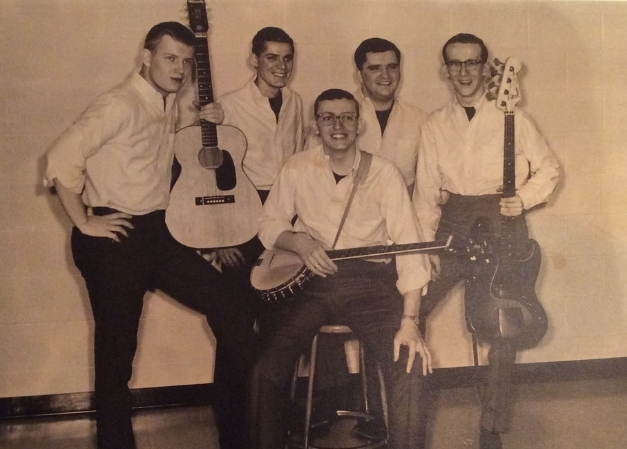
In 1963, Ken Wilson, left, Iain Crichton, Tim Rowat (seated), Larry Walsh and Brad Myers were ready for their school’s Beck On Call concert.
1963: Estelle Klein, Edith Fowke, Ken Danby, Ruth Schacter, Zal Yanovsky
Folk music was definitely on the rise in Canada. The heart of the folk music scene was Toronto where folk clubs were in such places as Yorkville and along Avenue Road. This was where the folk action was.
We auditioned one Saturday in the Spring of 1963 for a one-week gig at The Fifth Peg on Church Street, one of Toronto’s top folk clubs. We sang (successfully) for the club manager, Irving Kalb.
After the audition, Irving introduced us to Estelle Klein, one of the founders of Orillia’s Mariposa Folk Festival, and Canadian folk music specialist Edith Fowke. The two women were at the Fifth Peg to audition folk musicians for the third edition of Mariposa.
They had heard our music and offered us a spot at Mariposa, then and there.
We performed at The Fifth Peg several weeks later, along with an up-and-coming Canadian comedian by the name of Dave Broadfoot.
During that week we came to know a local artist who lived (with his pet ocelot) in a small apartment above the club. He was a graphic artist and was busy designing the posters for Mariposa. Ken Danby went on to a wonderful career as an artist.
One other name stands out from our week at The Fifth Peg. He introduced himself as Valdemar Horsdal. He heard the Towne Criers a couple of times — and would meet us again.
“Folkie hopefuls” were also drawn to The Bohemian Embassy, an upstairs folk club at 7 St. Nicholas St. run by Don Cullen and Margaret Atwood. They had their club listed under “Embassies” in the Toronto phone directory!
Impromptu hootenannies and “happenings” took place every weekend and we were often there to sing a few songs and listen to other individuals and groups.
One weekend in early summer 1963, we were at the “Embassy” sitting with a Toronto fan, Ruth Schacter. We had already been up to sing. A shaggy looking guy came over to our table. Ruth looked up at him and said, “Have you got the money you owe me.”
He replied with an explicit remark to Ruth, then he turned and asked if he could borrow my guitar to do a couple of songs. “OK,” I said.
The back story is that his name was Zalman Yanovsky. At that time, he was, literally, bumming around Toronto, “singing for nickels and dimes” and, according to Ruth, sleeping in laundromats. She had loaned him $125.
He did get some breaks and eventually became a member of The Lovin’ Spoonful. He is mentioned by name in Creeque Alley by The Mamas & Papas:
“Zal and Denny (Doherty), working for a penny, Trying to get a fish on the line.”
The Summer of ‘63: On the Beach at the Bend
At this time there were two other London folk groups who garnered great reviews and large crowds. One was The Lowlanders led by John Tyson, a doctor in London. The second was Group One, a folk trio, led by Jay Boyle. Group One had a hit on local radio stations with their song The Black Donnellys. The three groups were approached by CFPL radio/television in London, who pitched a series of hootenannies around the London region. These “hoots” were to be MC’d by CFPL on-air personalities, known as The 980 Moonshiners: John Dickins; Dave Wilson; Al Mitchell; Dick Williams, and Bill Murray.
The first “hoot” was held inside the Grand Bend Casino Hall on Aug. 4 at 8 p.m.. It started, more or less, on time to an audience that filled the hall to capacity. Those inside were enthusiastically responsive to each group, but thousands (literally) were left outside, clambering to get in.
The casino owner, Eric McIllroy, in consultation with CFPL, called a halt to the indoor music and announced the event would continue outside on the beach. The whole sound and light system was moved — and the “hoot” resumed with an audience, estimated by The Free Press, to be 7,500 fans. The casino capacity overflowed at 2,500! Grand Bend rooms sold out, with some driving about thirty miles to Clinton to find accommodation.
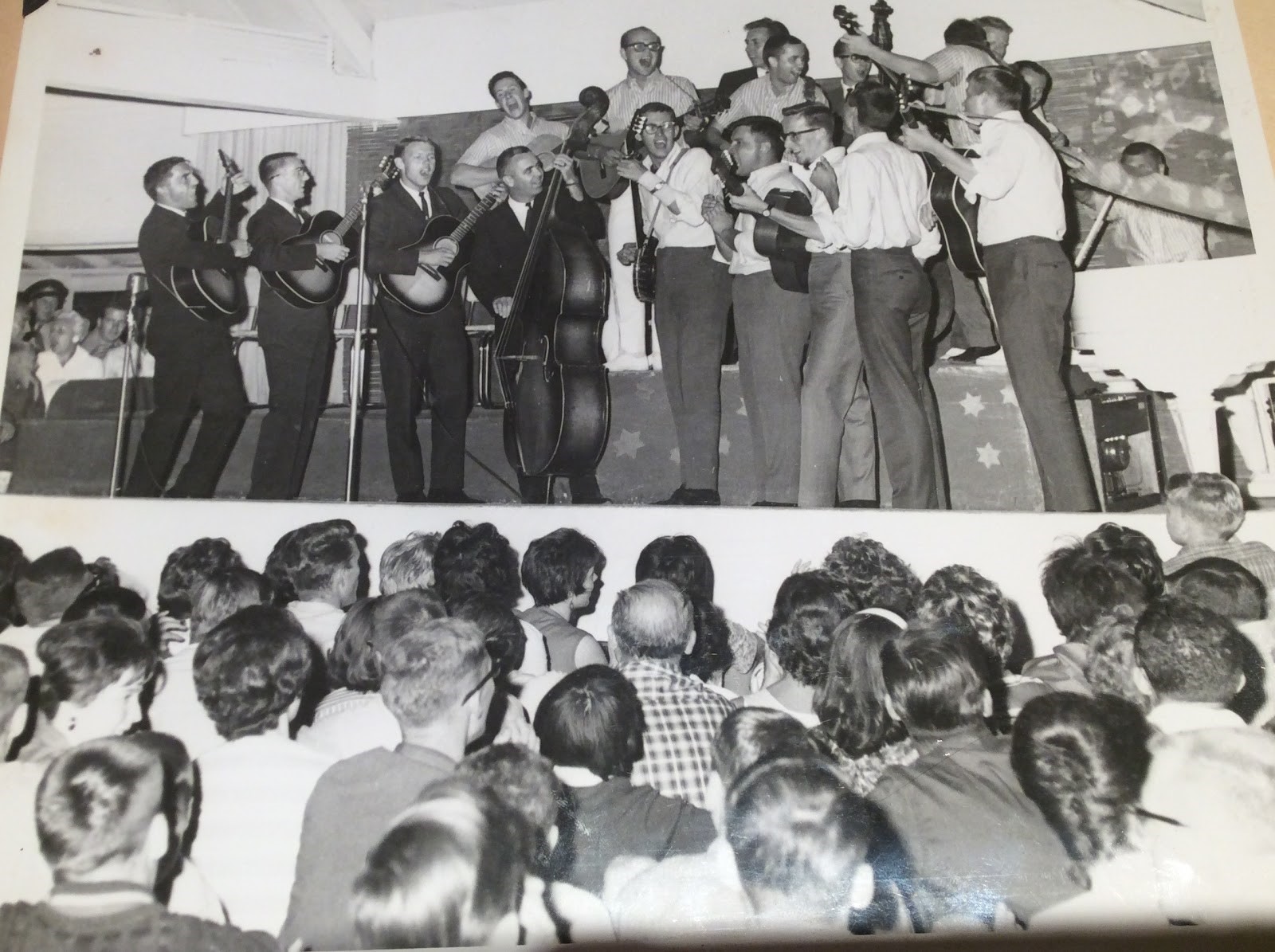
Thousands of folk fans jammed Grand Bend’s Casino Hall on Aug. 4, 1963 for a “hoot” with London-region acts. Because of the overflow crowd, the show was moved to the beach with 7,500 fans taking it in.
Mariposa 1963: After the festival, a founding member departs
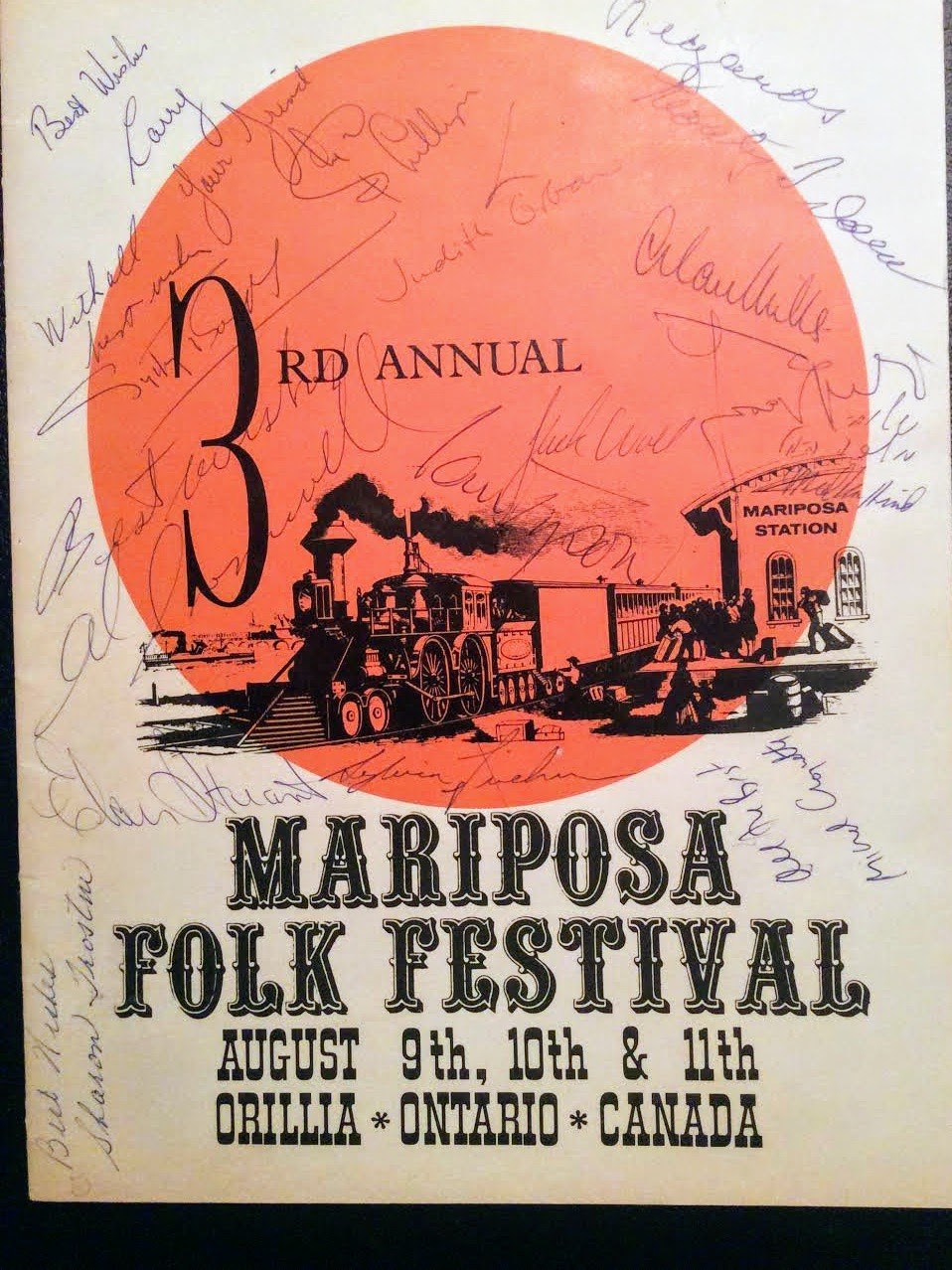
Acclaimed Canadian artist Ken Danby designed the poster for the 1963 Mariposa Folk Festival. Among the performers who autographed this one for Larry Walsh were Chatham’s Sylvia Fricker of festival headliners Ian & Sylvia and Sharon Trostin, later of Sharon, Lois & Bram.
The Towne Criers arrived, excitedly, in Orillia for the 3rd Annual Mariposa Folk Festival. What a time it was.
We appeared as the first of three closing acts after the intermission at the Friday night opening concert. Lamont Tilden was the MC for the whole week-end. A big folk fan himself, his introductions were usually brief...to leave more time for the music. We were followed by Bonnie Dobson, and Ian & Sylvia. Audience size was estimated at 5,500. The memory of those eager voices joining us in Last Night I Had the Strangest Dream remains with me to this day.
We returned to the Mariposa stage at 4:30 PM on Sunday as the opening act for the final concert. Joining us were Stu Phillips, Elan Stewart and Al Cromwell. Ian and Sylvia brought the whole festival to a memorable end. We returned home the next day.
Aboard a House Boat for Floating Concerts in the Kawarthas
Another highlight of the summer of 1963, after Mariposa, was a gig in the Kawartha Lakes and Peterborough. We were hired by radio station CKPT and spent several days boating through the Kawartha Lakes, stopping at well-known resorts where we would tie up and perform 20-minute folk concerts. The MC for these mini-concerts was “The Morning Mayor” — and the funniest guy I know — Don Percy. (Don is now in the Canadian Radio Broadcasters Hall of Fame)
Don would open the show with a couple of funny stories before introducing us. After we sang, we spent a few minutes distributing products provided by various sponsors. (Think of Donald Trump & paper towels in Puerto Rico.)
Following this, we spent three days at the Peterborough Exhibition doing the same thing on the CKPT sound stage.
The Towne Criers were in such demand, and were having such a good time singing, that we decided to put other plans aside and make folk music our profession for the immediate future. The sole exception was group founder, Tim Rowat, who, being a dutiful only child, followed his parents’ wishes and enrolled at UWO for the fall session. Brad, Iain, Ken, and Larry continued on as a quartet.
Let’s Sing Out at Casa Loma
We were approached in the early fall by CTV producer Syd Banks, artistic director at Mariposa. He invited us to participate in the filming of a pilot for a weekly folk music program to be called Let’s Sing Out, hosted by the well-known folk singer Oscar Brand.
We drove to Casa Loma in Toronto where the filming was to take place.. There Syd introduced us to the other participants: Claude Gauthier (Quebec); Gale Garnett (New Zealand/Canada); and The Serendipity Singers (USA). The filming of the pilot was a success and the series ran on CTV from late 1963 through 1966. It was then picked up by CBC and re-broadcast through 1968.
Mirroring the success of the American “hootenanny” series, each episode was filmed on a Canadian university campus. We were invited to a subsequent taping at the University of Waterloo where we paired, again, with The Serendipity Singers. We had lots of one-night concerts, as well as club dates in London, Sarnia, Toronto, Niagara Falls, and elsewhere.
Fall, 1963: Mariposa opened several doors
Mariposa opened several doors for us. Through one door stepped Bill Marshall & Gil Taylor, both well-connected businessmen in Toronto.
At Mariposa, we were without a manager. Ruth Schacter helped us make good contacts in the Toronto folk scene. She wrote to us in London saying that these two were very keen to “take us in hand” and become our managers. She
recommended we accept...and we did.
Firstly, Bill & Gil recommended a change in ”look,” taking us to their favourite men’s shop and outfitting us at their expense, We then visited The Razor’s Edge for stylish razor cuts, before going to Herb Nott, a noted Toronto photographer, for a series of promo shots.
We played a few gigs that they booked for us and became better known on the Toronto folk scene.
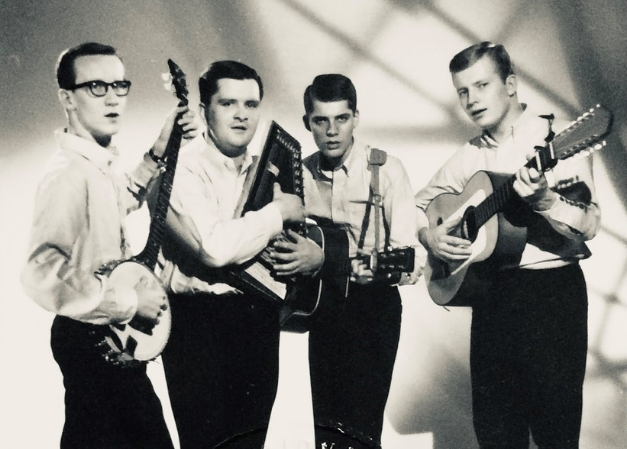
Brad Myers, left, Larry Walsh, Iain Crichton and Ken Wilson look sharp in a promo shot.
All this was preamble to their “magnum opus”, the World’s Biggest Hootenanny at Maple Leaf Gardens on Oct. 18, 1963. Twelve folk acts crossed the centre stage that night, all well-known groups on the local folk scene.
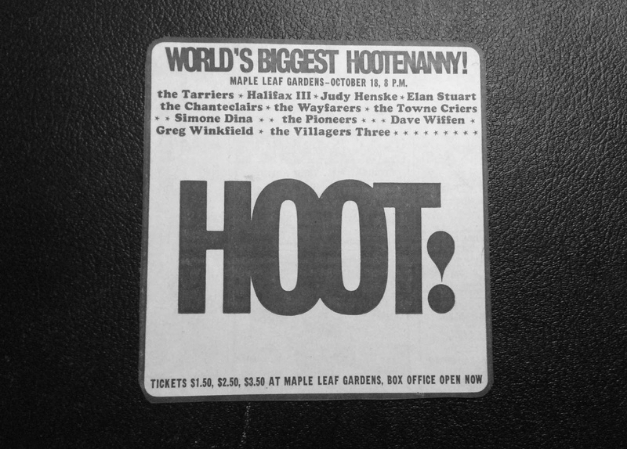
Folk fans will be impressed by the bill for 1963’s World’s Biggest Hootenanny. Among the acts is Ottawa’s Dave Wiffen. Ten years later, David Wiffen would be among the first to record a Willie P. Bennett song, as detailed in the Singing Along Post by Paul Mills.
Sadly, the logistics and sound set-up of this massive arena did not lend themselves well to this folk smorgasbord. Nor was the attendance what had been hoped for. What saved the day, financially, for them was that they had taken out “box-office insurance” which covered all costs.
Following this, things fell apart, as their interest in being folk group managers waned.
An old Irish adage goes as follows: “The good Lord doesn’t close one door, but he opens another”.
We were soon called upon to open a new folk venue in London — The Smoke House.
Folkin’ at The Smoke House
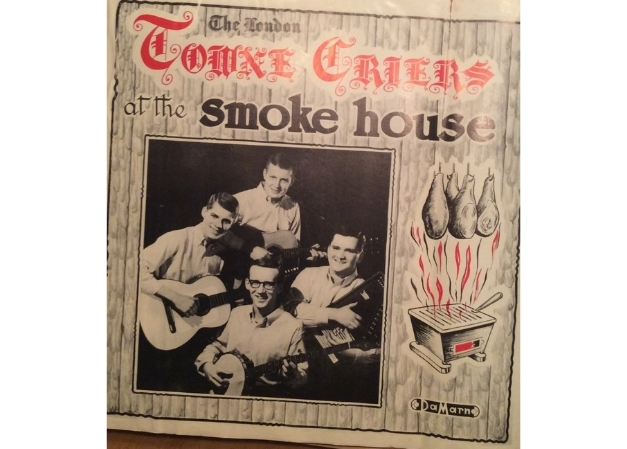
The Towne Criers added London to the group’s name in 1964 when it came time to record at the old CKSL-AM studio not far from their home base, a downstairs club at 232 Dundas St. The London Towne Criers at the Smoke House is on the DaMarn label, a London operation.
From November 18-30, we sang six nights a week in the newly-opened Smoke House, downstairs at The Country Fare Restaurant & Tavern located at 232 Dundas St. This was a low-ceilinged, intimate room with a raised stage in one corner and a good lighting and sound system. This became our musical base when we were not on the road.
We returned there for a week in December, and again for another week in January, 1964 plus being “held over” for one more week.
One closing night at The Smoke House, when we were packing up, a curly-haired chap carrying a guitar case came over to see us. He said he was the next act in the club. We introduced ourselves, as did he, saying, “My name is Gordon Lightfoot”.
Another door opened for us, as we were taken on by the Billy O’Connor Talent Agency in Toronto. They promised work in clubs both inside and outside of Ontario. They did not disappoint.
In January, 1964, we opened for two weeks at a folk club, The Venus de Milo Room, upstairs above a restaurant in the heart of Montreal on St. Catherine St. While there, we caught the attention of some McGill University Winter Carnival organizers who invited us to perform at the 17th Annual Winter Carnival Folk Festival on February 22.
Always ready for a new gig, we accepted, and subsequently returned to Montreal where we opened for The Highwaymen. It was a very moving experience to hear a few thousand voices singing Michael, Row the Boat Ashore.
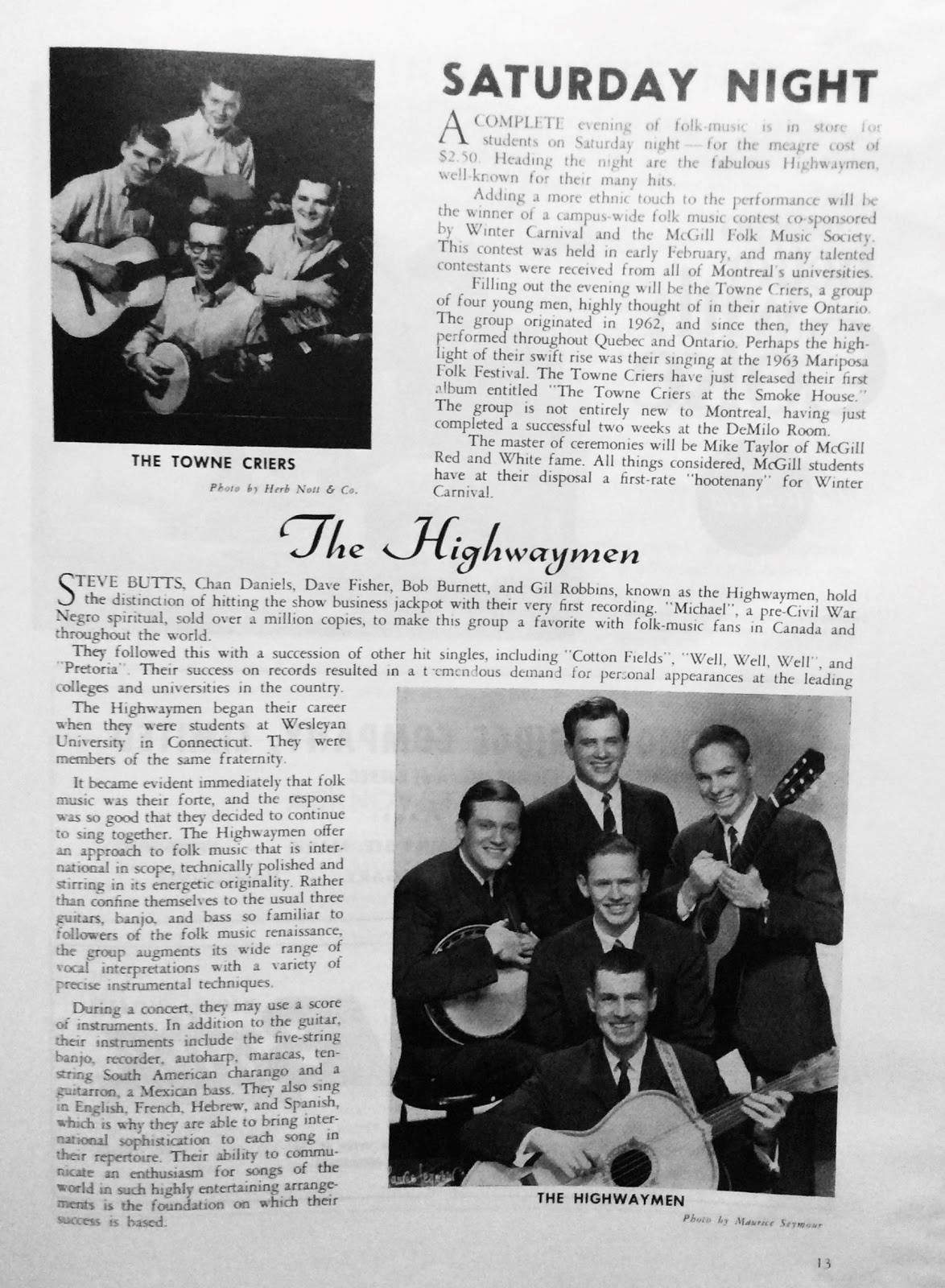
At McGill’s 1964 winter carnival, The Towne Criers were on the same page and the same stage as The Highwaymen, a chart-topping US “collegiate folk” group out out Connecticut’s Wesleyan University.
CFPL decided to continue with their “hoots,” but in a different format. The Towne Criers, Jay Boyle’s Group One, and The Lowlanders moved to television for a 13-week summer series of televised outdoor “hoots”. Each half-hour episode opened with one of our three groups doing a song or two. Then a lesser-known local group came to sing, followed by one of our groups closing out the show.
There were four 90-minute tapings held in June, July, and August.
On the road again: A song by Joni Mitchell (as we know her now) is shared
True to their word, The Billy O’Connor Agency arranged a couple of one-week gigs at the Fourth Dimension Folk Clubs located in Winnipeg and then Regina. We were well advertised in the Winnipeg and Regina papers, drawing enthusiastic crowds almost every night.
One evening in Winnipeg, we took a long break and drove downtown to hear another “up and coming” group called The Irish Rovers.
Sunday night was “Hootenanny Night” when aspiring singers would get an opportunity to perform a song. One of us would introduce the singer and then it was their turn at the mike.
This Sunday night “hoot”, in hindsight, was a memorable one. At the end of our first set, we announced that if there was anyone in the audience who would like to come up and sing a song, “Please come and see us.”
A young woman, about our age, with long, straight, blond hair, approached us, introduced herself as Joannie Anderson, and asked if she could do a song. “Certainly,” was the reply. And so she came to the stage with her guitar, was introduced, and sang a lovely song that she had written herself. Her song was very well-received by the audience.
Following her song she came to our table and asked if she could join us for a few minutes.
“Certainly.”
And so she shared that she had come down from Saskatoon where she lived and had played a few small gigs. She said that she was really eager to try and break into the folk scene. She knew there were major folk clubs in Vancouver, as well as in Toronto, and she asked our opinion of where she should go.
“Go to Toronto” was our unanimous reply. And we named some of the popular clubs that she might look into in Yorkville and on Avenue Road.
So she chatted with us for a while before our next set. I commented positively on her blue sack dress. She said she had made it herself. (Several years ago I read her autobiography and read that, at that period in her life, one of the things that she did to save money was to make her own clothes. This ties in nicely with our brief conversation about her dress.)
Larry Walsh said he really enjoyed her song, which she said she had composed herself. He asked if he could have a copy of it, if possible.
“I don’t have a copy with me, but I would be pleased to write it out for you”. She was thrilled to be asked.
The Fourth Dimension in Regina was a downstairs club, located below Sammy’s Pizza Palace. Larry went upstairs and quickly returned with a cardboard pizza round. She immediately wrote out the lyrics, signed it, and gave it to Larry.
So we, The Towne Criers, like to think that we played some small part in helping her career along.
Larry was the archivist of the group and kept a personal scrapbook of clippings and photos of our gigs from the very beginning through to when he & I left the group in August, 1964. He put this hand-written song in his scrapbook.
Larry went to London Teachers’ College in September of that year, enrolling in the two year program which was available for Grade 12 graduates. I worked at Eaton’s for the 1964-1965 school year and enrolled for the one-year program in September, 1965. Tim Rowat departed university and enrolled at the same time. The three of us sang together on a few occasions while at the teachers’ college.
Tim and I, having so enjoyed our time in Peterborough, accepted teaching positions there for September, 1966, while Larry began his teaching career in London.
Larry died, far too soon, in 2001 of a sudden heart attack.
Iain followed a few years later.
In the summer of 2015, Larry’s widow, Helen, and her sister came to visit us on Isle aux Coudres. She had previously asked if I would like to have Larry’s Towne Criers scrapbook. “Certainly” I replied. She gave it to me on that occasion.
Sadly, the hand-written Joannie (Mitchell) song was not there. Helen had known of this item for a long time and had looked through Larry’s things...but to no avail. Quite a mystery!
After our two Fourth Dimension gigs, we took a leisurely drive through the northern United States in returning to London from Regina.
At some point during that 1964 road trip, Larry and I discovered that we were both thinking of leaving the group at the end of August, and so we announced our decision to Ken and Ian. We parted amicably.
Before The Goldrush: When Valdy met Neil
But that is not quite where The Ballad Of Towne Criers ends.
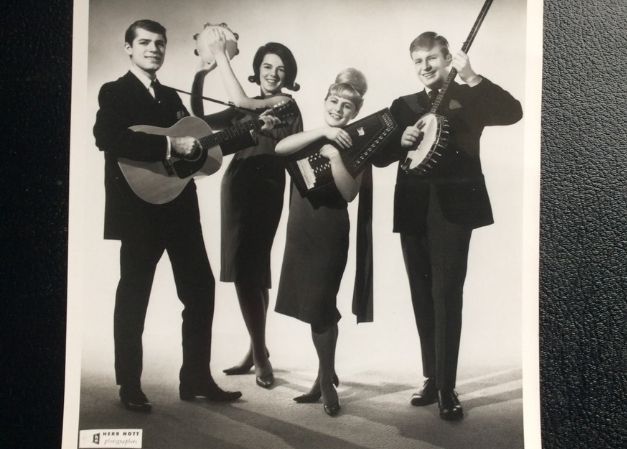
Iain Crichton, left, Shauna Kelly, Carol Barnes and Ken Wilson were the next edition of The Towne Criers, seen here c. 1964.
The group went on after contacting two wonderful-voiced females who had appeared at the “hoot” in Winnipeg earlier in the summer. Shauna Kelly and Carol Barnes were thrilled to join and the club gigs continued, both in and outside Ontario, through the Billy O’Connor Agency.
Carol, subsequently, left the group and was replaced by Valdemar Horsdal. He had first met us in Toronto at The Fifth Peg. He, too, had appeared at a Fourth Dimension “hoot” and had kept in touch. He worked at the old Kelvinator plant in London — and was later famous as Valdy.
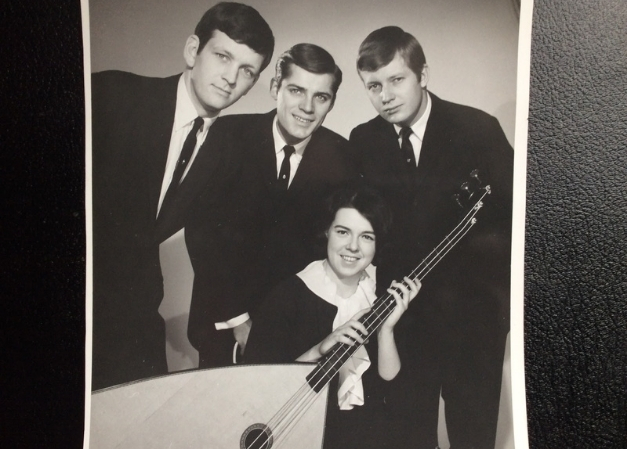
The penultimate Towne Criers lineup had Valdemar Horsdal, left, Iain Crichton. Shauna Kelly, who is holding the group’s bass balalaika, and Ken Wilson. Founding member Brad Myers had bought the big instrument at a Lakehead pawn shop in 1964 and “willed” it to the group when he left later that year. Ken Wilson bestowed it on Valdemar when the group broke up.
In 1965, the Towne Criers headed West again. They stopped for a gig at the Lakehead. Ken Wilson takes up the tale: “On a Thursday evening about an hour before showtime, an old black hearse showed up at the club. Inside was a trio from Winnipeg. They were traveling east to the Big Smoke to make their fortune. They asked the manager if they could play an opening set before our show. He said it was up to us. We said, ‘Sure’ — one less set for us to do.
It was Neil Young, plus bass and drums.
“I thought they sucked. Shauna liked them because they were from Winnipeg, her hometown. Iain was non-committal as he often was and Valdemar thought they were great and the lead singer and songwriter was bound for glory.”
The group continued as a quartet … until Shauna decided to leave as well. The final Towne Criers lineup was as a trio, consisting of Iain, Ken, and Valdemar who later reappeared as Valdy.
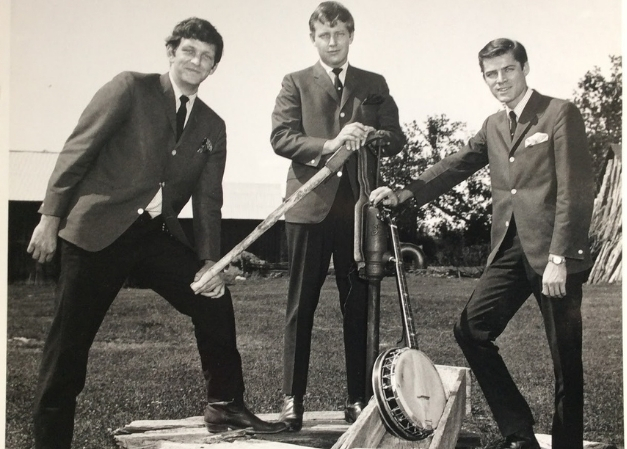
He was always envious of Brad Myers’s Martin D-28 guitar. It was made in 1947. Valdy’s Martin was a later issue.
The last Towne Criers lineup c 1965: Valdemar Horsdal, left, had first met founding members Ken Wilson and Iain Crichton when he saw the group’s original five-man lineup at Toronto’s Fifth Peg folk club in the spring of 1963.
The Towne Criers were an important part of the folk scene in the 1960s, in and about London, and beyond.As we have seen, they went on to meet, and interact with, some other "folkies" who went on to great fame and fortune: Ian & Sylvia, Zal Yanovsky (Lovin' Spoonful), Joni Mitchell, Gale Garnett, The Irish Rovers, The Serendipity Singers, Gordon Lightfoot, The Highwaymen, Valdy, and Neil Young.
The surviving members of the original Towne Criers are still making music. Tim Rowat is active with his voice, guitar & banjo near Peterborough. Ken Wilson sings and plays from time to time in Kingston. Brad Myers can be found living in French Canada (Isle-aux-Coudres) He sings, on occasion, and plays guitar in an open tuning, as arthritis has taken its toll on finger flexibility.
- Filed Under:
- London Music Office
-

LONDON MUSIC CENSUS AN OVERVIEW: TIP OF THE ICEBERG
The London Music Office embarked on its initial journey to understand…
Read Full Article